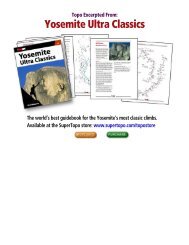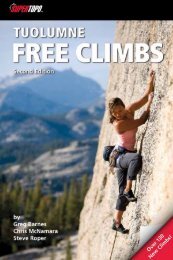The Definitive Guide To Yosemite Big Wall Climbing - SuperTopo
The Definitive Guide To Yosemite Big Wall Climbing - SuperTopo
The Definitive Guide To Yosemite Big Wall Climbing - SuperTopo
You also want an ePaper? Increase the reach of your titles
YUMPU automatically turns print PDFs into web optimized ePapers that Google loves.
Geology<br />
Geology of <strong>Big</strong> <strong>Wall</strong> <strong>Climbing</strong><br />
By Greg Stock, Geologist,<br />
<strong>Yosemite</strong> National Park<br />
<strong>Big</strong> wall climbing is all<br />
about geology. Sure, it also<br />
involves a lot of belaying,<br />
hauling, and cursing at<br />
portaledges. But when you<br />
get down to it climbing<br />
a big wall requires<br />
reading the rock in front<br />
of you. As a result, big<br />
wall climbers tend to be<br />
intrinsically aware of, and<br />
interested in, geology and<br />
geological processes. Here<br />
is some basic geology<br />
information that will<br />
hopefully expand your<br />
appreciation of <strong>Yosemite</strong>’s<br />
amazing walls.<br />
Rock type and fractures<br />
<strong>The</strong>re are at least a dozen<br />
different kinds of granitic rocks in <strong>Yosemite</strong><br />
Valley alone, ranging in composition from true<br />
granites like those on Leaning <strong>To</strong>wer and El<br />
Capitan, to the granodiorites of Half Dome<br />
and Liberty Cap, to the dark diorite of the<br />
North America <strong>Wall</strong>. Rock type can make a real<br />
difference in the climbing aesthetic; compare<br />
the ominous fractured diorite of the North<br />
America <strong>Wall</strong> to the clean granite splitters<br />
of the Salathé Headwall. <strong>The</strong>se rocks cooled<br />
from magma several miles beneath a chain<br />
of ancient volcanoes between about 105 and<br />
90 million years ago. Slow cooling resulted<br />
in large, interlocking crystals that make for<br />
very strong rock. In addition, unlike rocks in<br />
the Alps or the Rockies that were thrust up<br />
through the tectonic “rock crusher,” the granites<br />
of the Sierra Nevada were brought gently to<br />
the surface by prolonged erosion, resulting<br />
in relatively few fractures. It is this generally<br />
unfractured nature, along with tremendous<br />
rock strength, that allows for the impressive<br />
overhangs of Leaning <strong>To</strong>wer and El Capitan’s<br />
16<br />
Rockfall on El Cap, October 11, 2010. Photo Adam Long<br />
YOSEMITE BIG WALLS SUPERTOPOS<br />
southeast face. However, even the most massive<br />
faces still have fractures, namely sheeting joints<br />
(also known as exfoliation joints) that separate<br />
relatively thin slabs of rock from the cliff. Most<br />
flakes, including the feared “expando” flakes on<br />
the northwest face of Half Dome, are peeling<br />
away along sheeting joints.<br />
Glaciation<br />
Once <strong>Yosemite</strong>’s granites were exposed on the<br />
surface, they were sculpted by a number of<br />
different processes, most notably glaciation.<br />
<strong>Yosemite</strong> Valley was initially carved by rivers,<br />
but beginning about 3-5 million years ago<br />
glaciers entered the valley and converted what<br />
was probably a modest V-shaped river canyon<br />
into the dramatic U-shaped glacial valley of<br />
today. Repeated glaciations created the sheer<br />
walls of <strong>Yosemite</strong> Valley by abrading the cliffs<br />
and plucking away blocks. <strong>The</strong> most recent<br />
glaciation peaked about 20,000 years ago and<br />
retreated from <strong>Yosemite</strong> Valley about 15,000<br />
years ago, leaving behind glacial polish on<br />
many Valley walls.
















